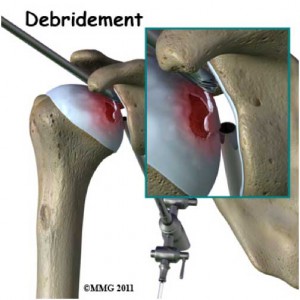Extensive Debridement–Shoulder
 Extensive Debridement Shoulder is a procedure used to remove debris and damaged tissue in the shoulder joint. This procedure is performed as minimally invasive as possible by using a very small camera called an arthroscope. Your doctor may recommend this procedure if you have damaged tissue in your shoulder joint, and conservative treatments are having no effect. Extensive Debridement Shoulder Surgery is an operation to help alleviate pain and restore your range of motion in the shoulder. For those who have a rotator cuff tear that isn’t able to be formally repaired, this operation often works well. The operation should be accompanied by physiotherapy to help get the rest of your shoulder muscles moving to the best of their abilities
Extensive Debridement Shoulder is a procedure used to remove debris and damaged tissue in the shoulder joint. This procedure is performed as minimally invasive as possible by using a very small camera called an arthroscope. Your doctor may recommend this procedure if you have damaged tissue in your shoulder joint, and conservative treatments are having no effect. Extensive Debridement Shoulder Surgery is an operation to help alleviate pain and restore your range of motion in the shoulder. For those who have a rotator cuff tear that isn’t able to be formally repaired, this operation often works well. The operation should be accompanied by physiotherapy to help get the rest of your shoulder muscles moving to the best of their abilities
Preparing for Extensive Debridement Shoulder Surgery
- You will probably be told not to eat or drink anything after midnight on the night before your surgery. This will reduce the risk of vomiting while you are under anesthesia.
- Because the anesthetic and pain medications may make you drowsy and you will be unable to drive, arrange for someone to help take you out of the hospital and drive you home when you are released.
- Wear a soft, comfortable shirt that will not irritate your skin when worn under a shoulder sling.
- Make sure you have received any equipment you will need when you get home from the hospital. This may include a shoulder sling, ice packs or coolers, or heating pads. You should receive prescriptions for any of these from your doctor when your surgery is scheduled.
- Any physical problems, such as a fever or infection should be reported to your surgeon, and you should notify your surgeon of any medication you are taking.
- If the surgery is not being done arthroscopically, discontinue use of any anti-inflammatory medicine, especially aspirin, a week prior to surgery, to prevent excessive bleeding during the surgical procedure.
Extensive Debridement Shoulder Surgery
Extensive Debridement Shoulder Surgical Procedure Anesthesia is applied and several small incisions are made in the shoulder. A small camera called an arthroscope is inserted into one of the incisions. The surgeon uses this device for image guidance during the procedure A tool is inserted into one of the small incisions to fill the joint with fluid. This expands the joint, giving the surgeon more space to examine the damage. The surgeon uses special tools to repair the damage found. In a process called debridement, loose or damaged cartilage is removed. If present, bone spurs may be filed down. The fluid pumped into the joint is drained, tools are removed, and the incisions are closed with surgical staples or sutures. A bandage is applied to the shoulder, and the patient may be given pain relievers. After surgery you will receive stitches and be taken to the recovery room. The stitches are usually removed in two to three weeks.
Extensive Debridement Shoulder Recovery
After Extensive Debridement Shoulder Surgery, some pain, tenderness, and stiffness are normal. You should be alert for certain signs and symptoms that may suggest the development of complications.
- Fever after the second day following surgery
- Increasing pain or swelling
- Redness, warmth, or tenderness which may suggest a wound infection
- Unusual bleeding (some surgical wound drainage is normal and, in fact, desirable
- Numbness or tingling of the arm or hand
- You should move your fingers and hands in the sling as much as possible to help circulate blood.
Risk
There are always some risks with any surgery, even arthroscopic procedures. These include possible infection, and damage to surrounding nerves and blood vessels. However, modern surgical techniques and close monitoring have significantly minimized the occurrence of these problems.
